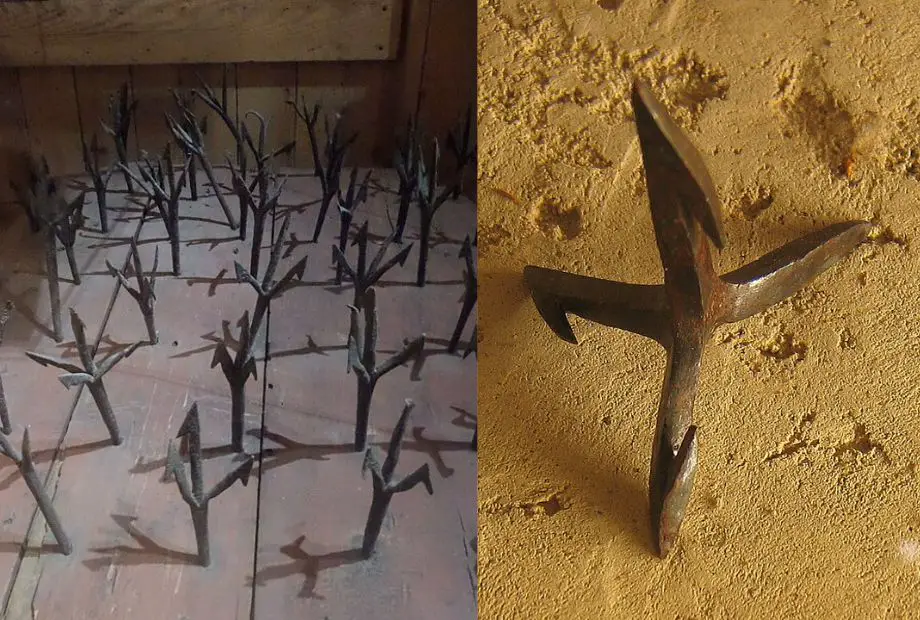Breaking news
Ukrainian Forces deploy caltrops from Drones to slow Russian Supply vehicles advance.
The Russians are facing a new threat behind the front line: tire-popping metal obstacles called caltrops dropped by Ukrainian drones. It is an ingenious new use of a very old weapon, which is causing problems for Russia’s already overstretched last-mile supply chain by halting vehicles so they can be hit by bomber drones.
Follow Army Recognition on Google News at this link

Ukrainian mass-produced Caltrops (Picture source OSINT )
FPV kamikaze drones regularly hit Russian logistics vehicles ferrying supplies to front-line troops. The only way to get ammunition, food, and other supplies through the danger zone is to pack them into UAZ-452 Bukhanka (“Loaf”) vans and make a dash at top speed. Ukrainian operators post a steady stream of videos of FPVs hitting Bukhankas at high speed with jokes about burned loaves. Now the Loaf drivers have to look down as well as up.
Jagged Iron
Ukrainian drones are strewing the roads with four-pointed metal weapons designed so that whichever way they fall, one point is always upwards. The name caltrop comes from the Latin for ‘heel trapper;’ the Romans also called them murex ferreus or ‘jagged iron,’ but they go back even further. Caltrops can be dated at least to 313 BC when Alexander the Great’s army used them against Persian cavalry.
Roman caltrops were jagged so that the point would stick in a horse’s hoof and be difficult to remove. Caltrops in various forms were used through the ancient and medieval eras and were still in use in the eighteenth century.
In the 20th century, the caltrop made a comeback for attacking rubber tires. During WWII American O.S.S. mass-produced caltrops and distributed them to resistance fighters in Europe. Simpler and more reliable than explosives, they could be scattered on roads to stop German vehicles, either as harassment or as a prelude to an ambush.
The Germans also used caltrops in WWII, which they called hedgehogs or crow’s feet, developing a version that could be dropped in canisters from the air. One canister could scatter a thousand caltrops, and targets included airfields as well as roads. The hedgehogs were made of thin sheets of steel and weighed about 60g / two ounces each. Other versions, many of them improvised, have been used in the Vietnam War and other conflicts. Effective use relies on putting them in the enemy’s path in places where they may not be expected.

WW1 russian caltrops to stop infantry and light cavalry charges ( left ) and Ancient Roman caltrop to stop cavalry charges (right) (Picture source OSINT+ Royal Engineers Museum, Kent )
Drone Age Caltrops
Drones that can deliver payloads with precision are an obvious match for caltrops. A Chinese company showed off a caltrop-dropping drone at a military expo in 2019.
While the Ukrainians went through a flurry of caltrop-making in 2022, these were larger versions that were mainly emplaced by hand. They have not been seen much until recently pictures emerged on social media.
Russian Supply runs are typically made at night when there is less danger from FPV attacks, but driving at speed there may be little chance of spotting caltrops on the road. A vehicle that suffers a high-speed blowout might lose control and crash. But much worse is likely to follow.

In order : Ukraine drops Caltrops from a drone, Russian Soldiers show caltrops near vehicles (Picture source fighters on Telegram )
Drones Drop Anything, Anywhere
The Ukrainians have also used drones to drop anti-tank mines. But these are heavier, harder to obtain, and may not function reliably.
Caltrops represent a simple, low-cost way of stopping a truck so it can be finished off by a grenade-dropping drone. Ukrainian operators are world leaders at demolition by drone, though a truck may be a more difficult target than a tank. This is because tanks are invariably loaded with ammunition, and a grenade through an open hatch will usually start a fire leading to detonation, but a truck may take several attempts to ignite.
The tactic of dropping caltrops from drones will no doubt inspire a variety of other novel techniques. Drones can already place mines, ground sensors, and even small robots. The only limit is the imagination of the users
Defense News April 2024


























